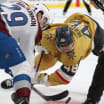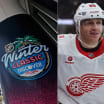The NHL Network will air every game of the 2025 IIHF World Junior Championship in Ottawa. It includes comprehensive coverage of the United States National Junior Team (1-0-0-0), which will play the second of four preliminary-round games in Group A against Latvia (1-0-0-0) at Canadian Tire Centre in Ottawa on Saturday (3:30 p.m. ET). The United States also will play Finland (Dec. 29) and Canada (Dec. 31). The playoff round begins Jan. 2.
NHL Network's E.J. Hradek will handle play-by-play with former NHL forward Tony Granato offering color commentary. Mike Kelly and Jon Morosi also will be part of the coverage, and longtime NCAA hockey analyst Dave Starman will provide in-studio analysis and will give his three keys to victory for the United States before each of its games during the 11-day tournament.
"Game 1 for Team USA was a 52-minute scrimmage and an eight-minute hockey game (in a 10-4 win against Germany on Thursday)," Starman said. "The positive is at 3-2, they managed the game, circled the wagons and fought their way through a loss of energy that happens in these games, especially a Game 1. As we have learned, the team that gets off the bus with the best players usually wins.
"One thing ran through my mind when it was over. It was a long, sloppy game. It reminded me of the opening game win over Denmark, 10-3, at the 2012 WJC in Edmonton. In that game, Denmark scored all three on the power play. The U.S. then lost the next three. They had Finland down 2-1 and lost. Then Petr Mrazek put on a show for Czechia and beat the U.S. It ended with a loss to Canada and a spot in the relegation round, where they beat Latvia."
Here are Starman's 3 keys to victory for the United States against Latvia, which opened its tournament play Friday with a stunning 3-2 win against Canada, clinched in the eighth round of the shootout. It was the third win ever for Latvia in the prelminary round.
1. Goaltending
"The Latvians will bring their best game of the tourney against the heavily favored Americans. Latvia can be like Slovakia; under-skilled, not as deep, but they play hard and they make you fight for your ice. Let's figure this is a one-off for Michigan State star Trey Augustine, who wasn't great (against Germany). He's got Michigan State ranked No. 1 in the nation and that wasn't by accident. He knows it was an off game but it gets late early at the World Juniors. My guess is you want to give someone else the net in this one as this realistically is the last layup game they have. Then again, do you give Trey back the net to mentally and physically fix what you didn't like in Game 1? There is no goalie controversy here. Does long time goalie guru and U.S. assistant coach David Lassonde, as good as it gets in this business, feel Augustine needs to play this game or does he get the day off to rest up and fight another day?"
2. Under and behind the coverage
"Chatting with U.S. assistant coach Brett Larson (St. Cloud State coach), one theme the U.S. wants to establish is finding soft ice underneath and behind the defense. Their speed was too much for Germany. When Germany tightened gaps, the U.S. went wide. When they softened, the U.S. attacked east-west in front of them to spread them out. And as my NHL Network studio colleague pointed out, Germany's third forward was a bystander all game allowing the U.S. to attack up the middle. Against Latvia, will we see more of an effort to deposit pucks behind the defense, establish the ground game, cycle more and go low to high? Against Finland and Canada, that has to happen and those little possession plays in hard areas usually find you a goal you need at the most important times."
3. Offensive zone face-offs
"The U.S. was 16-for-29 in the offensive zone on draws (per Sportlogiq), 9-for-9 in the left dot. Remember, face-off rules in terms of first engagement off the drop of the puck are different in the International Ice Hockey Federation. You cannot use your feet or body, only your stick. As per USA Hockey National Team Development Program Under-18 team coach Nick Fohr, 'You must go to the puck with your stick, and you are not supposed to be able to block your opponent's stick off the draw.' These kids have all played IIHF rules before, but it could take a game or two to get the timing back needed for these types of draws. This will get better, but is worth keeping an eye on. When it does, make sure Nick gets some credit for it as his tutelage in this area was given to a few of the centers on this team."






















